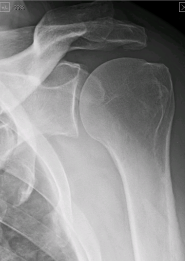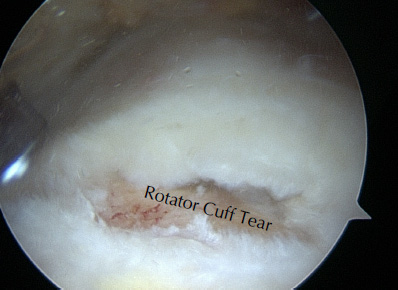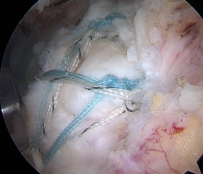Shoulder Tendon Tears and Rotator Cuff Tears
Anatomy and function of the rotator cuff

The shoulder is a ball-and-socket joint between the upper arm bone, which is called the humerus, and the shoulder blade, which is called the scapula. The ball is on the top of the upper arm bone and the socket is on the shoulder blade. However, the socket is not a full cup, it is a shallow depression similar to a golf tee. To prevent the ball from slipping over the edge of the shallow socket and dislocating with heavy lifting, the rotator cuff compresses the ball into the socket. The rotator cuff is a group of four muscles and tendons (the supraspinatus, the infraspinatus, the subscapularis, and the teres minor) that surrounds the ball like a glove. When the ball is compressed into the socket, the shoulder joint is a stable rotational fulcrum. This stable rotational fulcrum allows the arm to lift heavy weights above shoulder and head level.
Rotator cuff tears

With age, the rotator cuff tendons degenerate. If the tendons become too degenerated, they can tear. Over time, rotator cuff tears increase in size. This process is very slow, taking place over years. The rotator cuff can also tear with trauma to the shoulder such as a fall. When the rotator cuff tears, the shoulder can become very painful. Reaching motions are often especially uncomfortable. Rotator cuff tears also often cause pain at night. These tears can also cause shoulder dysfunction. Range of motion and strength can decrease. This can be painful and limiting. Severe tears can result in a loss of the ability to raise the arm, which can be very disabling.
A variety of treatments are available for rotator cuff tears. Physical therapy, anti-inflammatory medications, and steroid injections are often recommended. Coupled with time, these treatments can alleviate pain, restore motion, and improve strength. In many people, these treatments are successful. However, with these treatments the rotator cuff tear does not heal. While these treatments may reduce symptoms, the tear persists.
Surgery


When therapy, medications, and injections have failed a surgical rotator cuff repair may be recommended. Most rotator cuff repairs can be performed through an arthroscopy. Arthroscopy is a minimally invasive way to perform shoulder surgery.
To repair the rotator cuff, Dr. Chalmers will first find and evaluate the tear. Tears are then repaired using sutures and anchors. Special extra-strength sutures are used for rotator cuff repair. These sutures are attached to anchors. Anchors are similar to hollow screws without heads. The anchors are placed into the bone. These anchors are made from biocompatible plastic. The sutures and anchors cover with scar tissue and do not need to be removed. The specific arrangement of sutures and anchors is customized to each individual rotator cuff tear.
Biceps tendon
The rotator cuff tear is next to the biceps tendon, which runs through the shoulder joint. Tendonitis of the biceps tendon is common with a rotator cuff tear. Tendonitis of the biceps tendon can be very painful. Commonly with a rotator cuff tear, Dr. Chalmers recommends removing the inflamed and irritated portion of the biceps tendon and reattaching the tendon to the upper arm bone. This procedure is called a biceps tenodesis.
Healing
Once the repair is completed, the tendon then needs to heal to the upper arm bone. The rotator cuff tendons heal more slowly than other tendons. Because the healing process is slow, recovery is slow after rotator cuff repair. By six weeks the tendon has healed enough to lift the weight of the arm, but nothing more. By twelve weeks the tendon has mostly healed. By six months the tendon has nearly fully healed.
Click here to download the PDF.
You will need the Adobe Reader to view and print these documents 
